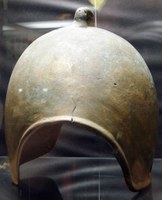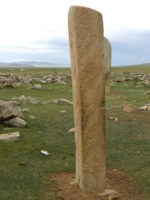Summer Scholarship: Karen Rubinson on East Asian Archaeology
In June, I participated in the 6th Worldwide Conference of the Society for East Asian Archaeology, held in Ulanbaatar, Mongolia. Three hundred scholars gave papers in 25 sessions; my presentation, “On the Road Again: Chinese Mirrors in Afghanistan,” was part of “Charting the Social Lives of Objects and Goods in China: Perspectives from Archaeology and Art History.”
The program of the conference was rich, with important research by students and junior and senior scholars on topics ranging from the early Paleolithic in Japan to Ritual Spaces, Images and Artifacts in areas of China, Siberia, Korea, Japan, and Mongolia, and of course, several sessions on aspects of the archaeology of Mongolia. One of my significant take-aways was that the transition from hunter-gatherers in Mongolia was not to an agricultural-based society but instead to a mobile pastoralist one. It underscored for me the important role landscapes play in the development of human societies. Having studied early periods in the Ancient Near East and China, but not the steppe, I found the papers that addressed this phase of the archaeology of Mongolia an important contribution to my education!
 During the meeting we toured the National Museum of Mongolia, which contains many of the archaeological collections from excavations in Mongolia, as well as ethnographic material. It was very exciting for me to see in person a cast bronze helmet that I have written about as part of a study on east-west Asian exchange (see “Helmets and Mirrors: Markers of Social Transformation” on my academia.edu page), having previously had only photographs generously supplied by my colleague Diimaajav Erdenbaatar, the excavator, one of Mongolia’s distinguished archaeologists.
During the meeting we toured the National Museum of Mongolia, which contains many of the archaeological collections from excavations in Mongolia, as well as ethnographic material. It was very exciting for me to see in person a cast bronze helmet that I have written about as part of a study on east-west Asian exchange (see “Helmets and Mirrors: Markers of Social Transformation” on my academia.edu page), having previously had only photographs generously supplied by my colleague Diimaajav Erdenbaatar, the excavator, one of Mongolia’s distinguished archaeologists.
 Subsequent to the meeting, a group of 40 of us headed out onto the steppe for five days to visit archaeological sites, the tour organized by Dashtseveg Tumen, another distinguished Mongolian archaeologist. The extraordinary landscapes of Mongolia are breathtaking and the distances are vast, much of it pasture for the herds of sheep, goats, horses, cows and yaks. We were fortunate to be there during a time of seasonal migrations, so we could see the now partially modernized process – the gers and belongings often being moved by trucks, the herds however on the hoof. Highlights of the sites we visited were a large deer-stone group in the Khanui Valley and the site Kara Balgas (“Black City”) in the Orkhon Valley, a Uighur capital now being excavated by Jan Bemmann, who will be a Visiting Research Scholar at ISAW next year.
Subsequent to the meeting, a group of 40 of us headed out onto the steppe for five days to visit archaeological sites, the tour organized by Dashtseveg Tumen, another distinguished Mongolian archaeologist. The extraordinary landscapes of Mongolia are breathtaking and the distances are vast, much of it pasture for the herds of sheep, goats, horses, cows and yaks. We were fortunate to be there during a time of seasonal migrations, so we could see the now partially modernized process – the gers and belongings often being moved by trucks, the herds however on the hoof. Highlights of the sites we visited were a large deer-stone group in the Khanui Valley and the site Kara Balgas (“Black City”) in the Orkhon Valley, a Uighur capital now being excavated by Jan Bemmann, who will be a Visiting Research Scholar at ISAW next year.